Peugeot Traveller review
If you need an eight-seater family van or executive shuttle, the peugeot traveller deserves a place on your shortlist.
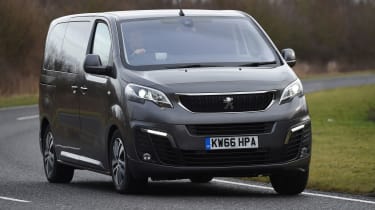
4.0 out of 5
- Generous equipment list, space for eight adults, excellent fuel economy
- Unpleasant gearchange, no entry-level model, noisy at speed

The market for eight-seater vehicles in the UK is small but meaningful, and the Peugeot Traveller is the French brand’s most convincing entrant yet. Peugeot’s confidence in the new people-carrier is best demonstrated by the choice of name. Whereas its predecessor simply added a ‘Teepee’ onto the title of the standard Expert van , the Traveller gets a name all of its own, distancing itself from its commercial vehicle origins.
• Best eight-seater cars to buy
The Traveller has some tough competition, not least from within its own family. Citroen and Toyota also produce very similar people carriers, named the Spacetourer and Proace Verso respectively. Running on the same platform and with the same engines as the Traveller, these three models are only separated by trim, equipment levels, pricing and some small design tweaks.
The three vans occupy somewhat of a middle ground in the size stakes. Though it’s available in three body lengths, even at its largest the Traveller is smaller than the likes of the Volkswagen Caravelle and Mercedes V-Class . It remains slightly bigger than traditional people carriers like the Ford Galaxy and SEAT Alhambra , so it faces an onslaught from both sides. It also has to entice family buyers from the newly redesigned Peugeot 5008 seven-seat SUV – a difficult task.

More reviews
New peugeot traveller 2017 review, used car tests, used peugeot traveller (mk3, 2016-date) review.
More interesting is where Peugeot’s positioned itself in the market. Leaving its sister vans to mop up the entry-level customers, the Traveller doesn’t offer a basic trim level. Instead, it begins with Active spec, which is packed with luxury features like a seven-inch infotainment display, climate control and rear tinted windows.

Step up to Allure, and you’ve practically got a limousine, stuffed with leather upholstery, electric and heated front seats and keyless entry. This is where Peugeot hopes to win buyers - with those looking to transport adults rather than families. It sees these Travellers being used as taxis, airport shuttles, or just general business transport.
• Best MPVs and people carriers
Engines are limited to diesels, though there’s a wide array of power outputs to choose from. Entry-level vans are powered by a 94bhp 1.6-litre, but there’s also a 114bhp 1.6 and 2.0-litre versions with 148bhp or 178bhp. Whatever engine you go for, economy is a real strong point – knocking most other van-based MPVs into a cocked hat with 50+mpg available from all but the most powerful engine.
The Peugeot Traveller is a world away from its predecessor, the rough and agricultural Expert Teepee . While the newcomer is still unmistakably a van, it’s to Peugeot’s credit that it feels a world away from its commercial vehicle predecessor on the road as well as when you’re sat inside.
Car-like it may be, but the Traveller is still a van, and inside it’s every bit as spacious as the load-lugger it shares a body with. Available with eight seats across three body lengths, no matter which Traveller you choose there’s space to seat adults in all three rows. Boot space is generous, if awkwardly shaped, and massive sliding doors mean the Traveller is very easy to get into and out of.
Though it’s unlikely to draw much custom from the ranks of private buyers, the Peugeot Traveller stands out as an executive minibus or small luxury shuttle. That’s mostly due to price – to spec a similarly sized VW Caravelle or Mercedes V-Class to the same level would set you back significantly more money and the Peugeot can live with this company in terms of its cabin ambience. Those vans can’t compete with the Traveller’s running costs either – it has impressively low fuel consumption and emissions for such a big, heavy vehicle.
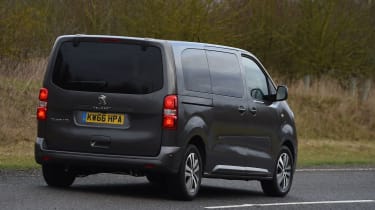
Engines, performance and drive
The Peugeot Traveller rides on an adapted version of the EMP2 platform underpinning MPVs like the Citroen C4 Picasso . That could be why ride and handling are surprisingly good for a van-based people carrier. It doesn’t suffer from excess bounce in the rear suspension when it’s unladen, and proves comfortable across all but the worst roads.
Good visibility and a tight turning circle mean the Traveller feels smaller on the road than its bulk suggests, and it proves pretty easy to manoeuvre and park thanks to large door mirrors and standard-fit rear parking sensors.
• Citroen Spacetourer review
The Traveller is reasonably settled at motorway speeds, but twisting A and B roads highlight the steering, which is low geared and vague without much feedback. The gearshift, too, isn’t up to much, feeling loose and imprecise – it doesn’t have the same pleasing action as the ‘box found in a Ford Tourneo Custom .
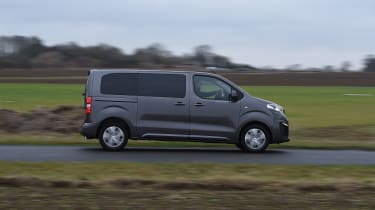
Two different automatic gearboxes are available – an ETG6 automated manual on lower-powered models or a traditional EAT6 torque converter on the most powerful 178bhp engine. We’d avoid the automated manual like the plague, as it offers slow, jerky shifts that leave you with no confidence when pulling out at fast junctions, for example. By contrast the EAT6 is smooth and changes gear quickly, but it isn’t available on any other engines bar the most powerful one – making it an expensive choice.
The driving position is resolutely upright and van-like. While this ensures good visibility out of the front, it’s not perfect – taller drivers will find long legs get cramped quite quickly. We found the active safety aids such as optional-fit lane departure warning were far too trigger-happy, leading us to turn them off almost instantly. Allure models get a heads-up display though, which works well, and means you don’t have to take your eyes off the road so often.
Two engines are available for the Peugeot Traveller – a 1.6-litre or a 2.0-litre BlueHDi diesel, with a choice of four power outputs between them. The range kicks off with a 95bhp 1.6-litre, which is fine for town work but not much else – if the back was loaded up with six passengers, you’d probably be struggling to keep up with traffic. A top speed of just 90mph means it suffers on the motorway, too.

Moving up, there’s a 114bhp version of the same engine, which shaves a couple of seconds from the van’s 0-60mph time and boosts top speed to 99mph. That’s better, but if it were our money we’d plump for the 2.0-litre 148bhp unit. This is a really flexible engine, with bags of torque helping you press on without having to rev too hard. It feels strong and should have no problems transporting a full load of passengers and luggage.
The 178bhp engine is more powerful still, but it seems like a waste of money when the 148bhp unit is so good.
MPG, CO2 and Running Costs
Peugeot and sister brand Citroen have some of the best average economy across their passenger car ranges, so it’s no surprise that the Traveller continues this trend. Compared with the VW Caravelle , which offers mpg figures in the mid-30s for most models, it’s only the most powerful Peugeot Traveller that dips below 50mpg.
Official figures suggest the economy champ is the short-wheelbase 115bhp 1.6-litre BlueHDi diesel equipped with stop-start technology. It claims to return an astonishing 55.4mpg, with CO2 emissions of just 133g/km, ensuring a reasonable tax bill for private and business buyers alike.
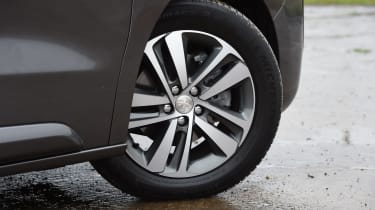
Our favourite 148bhp engine doesn’t shame itself, though, with an impressive return of 53.3mpg on the combined cycle and CO2 emissions of 139g/km. We’d expect you to get closer to official figures with the higher-powered unit, too, as you won’t need to work the engine so hard to keep up with traffic.
Stop-start technology is available in various forms across the range, and the resulting fuel savings mean it’s well worth buying a Traveller with it.
Insurance groups
The Traveller starts out in Group 11E for lower-powered models. This quickly rises, and our favourite 148bhp engine is in insurance group 22E. The range tops out at group 24E for top-spec models. That’s still lower than even entry-level versions of the Volkswagen Caravelle or Mercedes V-Class , which start at group 28E and 34E respectively.
Interior, design and technology
The Peugeot Traveller is a smart-looking vehicle on the outside, aided by LED daytime running lights and body-coloured bumpers as standard. It’s impossible to disguise the car’s commercial vehicle origins, thanks to slab-sided styling, but a smart front grille and good-looking alloy wheels on Allure models can at least distract you from it.
Most Travellers will be silver, black or white, but if you’re feeling more adventurous it’s also available in a deep Dragoon Blue, Rich Oak or bold Amber Red.
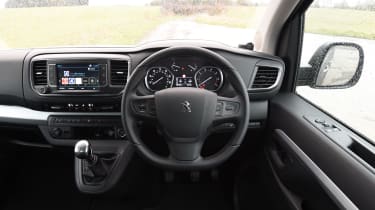
Inside, the Traveller can’t compete with more expensive models like the VW Caravelle when it comes to interior quality. It’s not that it’s poorly put together – build quality is excellent and there’s a notable absence of squeaks and rattles. It’s just material quality that isn’t up to the lofty heights of premium rivals, though if you’re coming from the old Expert Teepee you’ll be very pleasantly surprised.
An upright centre console contains a slick seven-inch touchscreen, which is mounted high up so you don’t need to take your eyes too far off the road to operate it. You will need to lean forward, though, and that can be a stretch for smaller drivers. On top of the dash sits a heads-up display, which is easy to read and gives all the information you need.
Active models have cloth upholstery but still retain a leather steering wheel, which feels comfortable in hand, while the solid metal gearknob is very solid and reassuring. Stepping up to Allure brings you easy-to-clean leather upholstery for added luxury, while it also adds heating to the two front seats as well as electric adjustment. Dual-zone climate control is standard, as are cruise control, electric mirrors, automatic headlights and wipers, and a handy mirror to survey those sat in the back seats.
Sat-nav, stereo & infotainment
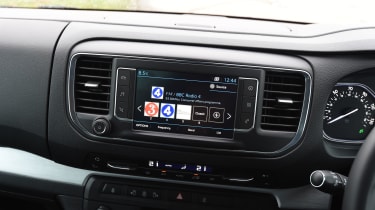
A seven-inch touchscreen infotainment system comes as standard on the Traveller, and we found it pretty easy to use. It offers up all you’d expect – DAB, Bluetooth connectivity, a USB port and aux-in, as well as Mirror Link Smartphone connectivity, but Apple CarPlay and Android Auto are sorely missed.
Sat-nav is a £240 optional extra.
Practicality, comfort and boot space
Passenger space is where the Traveller shines, with even the Compact models offering space for adults in all three rows. Unlike some rivals, including its Citroen and Toyota siblings, the Traveller isn’t available with a double front passenger seat, so it’s limited to eight rather than nine seats.
Massive sliding doors mean it’s simple to get into and out of, and even rear seat passengers get a good view out thanks to large side windows. The rearmost two don’t open, though, so the air-conditioning will be getting a workout when the van is fully loaded.
Boot space in the standard wheelbase model is a generous 640 litres with all three rows in place, though it’s rather tall and shallow – you’ll be stacking shopping bags on top of each other.
Sliding rear seats allow you to strike a balance between leg room and rear seat space - especially important in Compact models, where rear legroom is tight unless some boot space is sacrificed. Both rear rows of seats are removable, and when out they leave a truly cavernous load area.
Cabin storage is decent, with a sizable glove box. The door bins are large, but positioned so low down that they’re difficult to access while driving.
The problem with a van-based MPV is flexibility. While both rear rows of seats slide and fold, they don’t leave a flat loading bay unless you remove them entirely. Taking them out is a two-person job, as they’re very heavy. A car like a SEAT Alhambra simply folds the seats directly into the floor, leaving a flat load bay – a much more practical option to have.
It might surprise you to find out that compared to an equivalent Volkswagen Transporter Combi, the Peugeot Traveller is actually wider, at 2,204mm. It certainly doesn’t look it, or feel it from in the cabin. It is shorter than the Transporter, though both in length and height, so it should prove easier to park.
Leg room, head room & passenger space

All three rows of seats offer enough space for a six-foot adult to sit comfortably, which is as good as you can say about the Mercedes V-Class or Volkswagen Caravelle . It’s certainly a vast improvement on most seven-seat people carriers, which tend to have third rows that are only really suited for children.
The high roofline means headroom is plentiful, too, plus there are ISOFIX mounting points in all six rear seats. Access to the third row is pretty simple – the middle seat tilts forward to provide easy step-through access.
Even the smallest Compact model still gets a 280-litre boot with all three rows in place. This rises to 640 litres for the standard model or 1,060 for the long-wheelbase. The load space is fairly tall and shallow, so you might find yourself stacking bags on top of one another, but it’s fine for suitcases and you can always slide or fold the rear row if you’re not using it to improve rear luggage space.
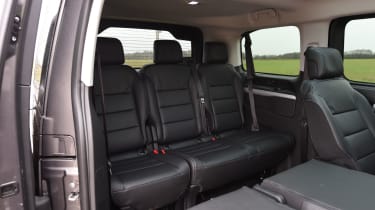
Remove all the seats and, in the standard length model, you’re left with a cavernous 3,200 litre load bay. You will need somewhere to store the seats, though, and they’re very bulky and heavy. While they don’t fold flat into the floor, you can fold them up and push them to the front of the load area to minimise their impact, and there’s still an uninterrupted flat area of almost a metre behind them.
Reliability and Safety
Even though it’s so new, there’s little under the skin of the Traveller that hasn’t been well-proven across many thousands of miles in other models. The engines all see service across Peugeot and Citroen’s ranges, while the EMP2 platform the Traveller is based on has been used for years underpinning the likes of the Citroen C4 Picasso .
The Traveller is too new to have made an appearance in our annual Driver Power survey, but Peugeot itself ranks 17th overall out of 32 manufacturers surveyed.
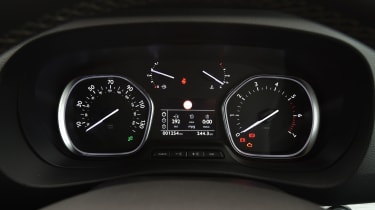
Family buyers should be reassured by its safety credentials, though. All Travellers get a five-star crash safety rating from the experts at Euro NCAP, with an excellent score for child protection. Driver assistance packs like a drowsiness monitor, active cruise control and optional lane-departure warning and road sign recognition mean the Traveller also scored highly in the safety assist category, while autonomous braking should help avoid any low-speed collisions.
The Peugeot Traveller offers up a three-year warranty, with unlimited mileage in the first two – handy for high-mileage drivers. That’s on par with most rivals, but the mechanically identical Toyota Proace gives buyers five years or 100,000 miles of cover.
Which Is Best
Cheapest vehicles.
- Name 1.6 BlueHDi 95 Active Compact 5dr
- Gearbox type Manual
- Price £28,909
Most economical vehicles
Fastest vehicles.
- Name 2.0 BlueHDi 180 Active Standard 5dr EAT8
- Gearbox type Auto
- Price £36,505
More on Traveller
- Traveller MPV
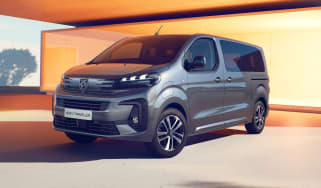
Updated 2024 Peugeot E-Traveller adds range, tech and style

Top 10 best 8-seater cars to buy
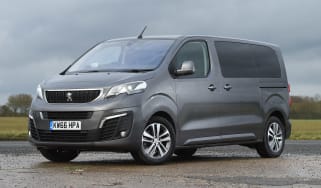
New all-electric Peugeot e-Traveller minibus revealed

Peugeot rolls into Geneva with Traveller i-Lab concept
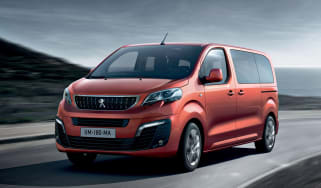
New Peugeot Traveller MPV revealed at Geneva Motor Show

Peugeot Traveller review: eight-seat MPV tested
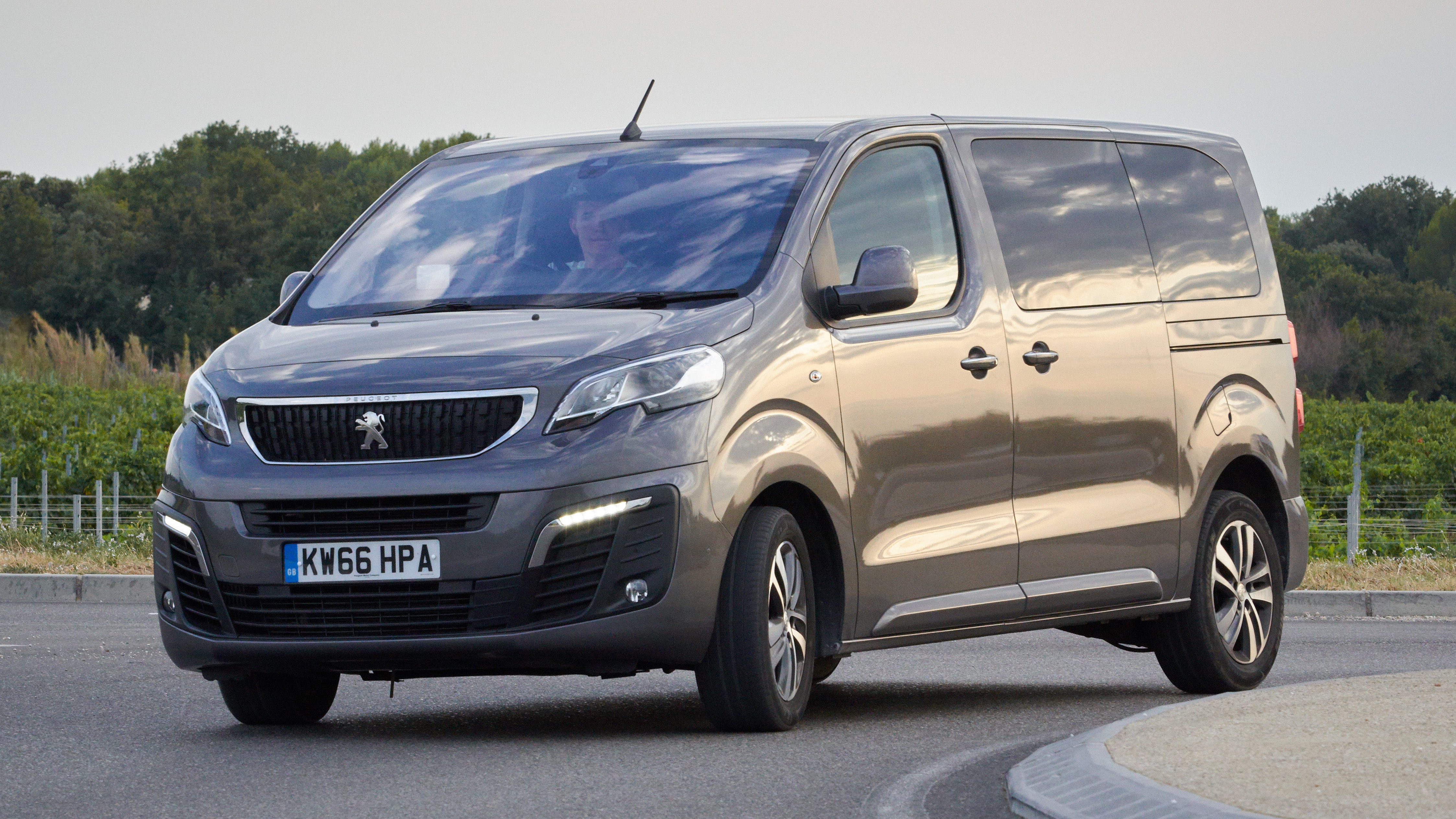
SPEC HIGHLIGHTS
That's not pretty.
No, but it's pretty useful.
It's an eight-seater. People-carriers and SUVs normally stop at seven. And you'd feel pretty useless if you drive off having left one of your intended passengers standing at the kerb.
But it's a van with windows…
It is, but not so crude as you might expect. Eight-seaters tend to fall into two sorts. The ones that really are vannish, with industrial cabins of hard walls and bare metal, and year-2000 equipment. Then there's the VW Caravelle and Mercedes V-Class that do at least have car-like trim and modern equipment, but cost a very stern £50k-ish each. This is £10k less, even in leather'n'nav trim.
So what exactly do we have here?
The Peugeot Traveller. (AKA Citroen SpaceTourer and Toyota ProAce Verso. They have different grilles and kit lists, but are essentially the same.) It's in Allure trim here, with the middle of its three available lengths. Size matters of course, and this one is below 5m long and, critically, under 2m high so it'll fit multi-storey car parks. It's handy and manoeuvrable, but it will still fit eight. In comfort.
Adults can fit in the third row – they'll have enough leg-room and width and their seats, like row two, individually recline.
Separate air-con is provided for the rear half with aimable vents, sunroofs, reading lights and electrical outlets. That goes to make the people in the back feel kindly treated.
Top Gear Newsletter
Thank you for subscribing to our newsletter. Look out for your regular round-up of news, reviews and offers in your inbox.
Get all the latest news, reviews and exclusives, direct to your inbox.
The words 'executive shuttle' come to mind.
Sure, there are obvious commercial uses for this thing, but it does have family-and-friends relevance too. It's pretty flexible. The Allure has two front seats, three behind and three more in the tail.
Also, you've got to go a long way to find a vehicle that can take three Isofix child seats in one row, let alone two rows as this one can.
Rows two and three split-fold and both of them slide. That leaves good opportunity for making the boot bigger.
There's a boot?
Of a sort. Behind row three it's 603 litres, a very tall space, but cramped front-to-rear. Though you can expand it by sliding row three forward a bit. You do get a parcel shelf. Beware – because the boot is tall, everything has to be stacked upright and tends to topple out when you open the tailgate. A partial solution lies in the tailgate glass, which opens independently.
All the seats fold, but only by dropping the backrests, not tumbling too. So they're still an obstruction. You can actually take them right out, but that involves deploying major muscle groups. Or a crane. Then comes the issue of storing them outside the vehicle.
Top Gear tests usually don't put the boot before the driving. but it's going to feel like a van, surely. Looks like a van. A van with chrome grille, fancy headlights and a set of alloys. Lipstick on a pig.
Sure, it's a very van-like driving position: you sit upright with your legs pointing down not forward. But it's not uncomfortable, even over a long haul.
Beyond that, the dynamics do make a passable impression of a car, albeit not a brilliant one. Much of the platform is actually shared with Peugeot's mid-size cars such as the 5008. So the suspension is mostly placid, and the ride decently supple. This does not happen with most vans.
The steering is remote and low-geared, but otherwise cornering is capable. Anyway, handling agility is about the last trait you want when there are six mouths behind you waiting to vomit down the back of your neck.
Anything in the way of performance?
The engine is a 150bhp HDi, and it does a stout job, without making much fuss. It supposed to be able to beat 100mph, but boy that'd need a run-up. The 0-62 time of 11 seconds gives a better impression of its ability, and of course that's before you add seven more warm bodies. The stubby little gearlever clearly meets the transmission via a tortuous path – its action is on the flaccid side.
Fuel consumption is also in the car rather than truck realm – 35mpg is easily achievable, on an official rating of 53.3mpg and 139g/km CO2.
OK so it's not bad to drive and it's got space. But is the cabin a happy place?
The dash is nicely designed and decorated, if not quite made of the same level of robust-yet-soft material in a Caravelle. The rest of the cabin is well-decorated, for instance fully shrouding the bare metal of the doors and seat mechanisms, and carpeting the entire floor.
The car-derived platform also means lots of useful electronics, including active cruise, a HUD with speedo and navigation arrows, CarPlay/Android Auto, and a parking camera.
As to happiness, we can't guarantee what congenial company your travelling companions are. But the actual hardware around you is moderately cheering.
But it's still a van.
Alright alright. Not a van-like car, no, but a car-like van.
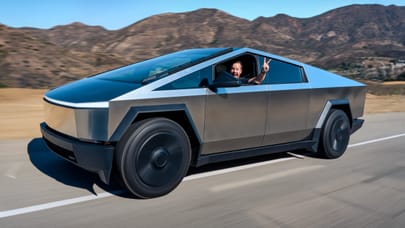
Here are 12 electric pickups you need to know about
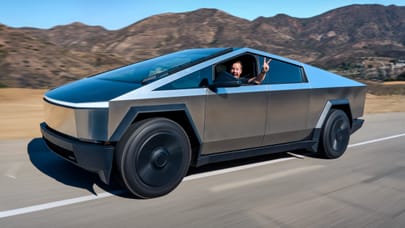
Tesla Cybertruck

These are the 12 best hot hatches of all time
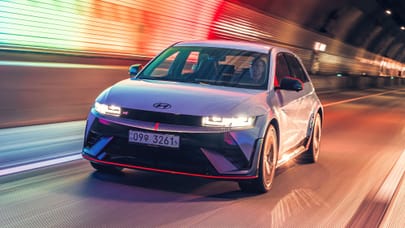
Top Gear's top 20 electric cars
Trending this week, behold, the twr supercat: a 600bhp+ v12-engined jaguar xjs, ferrari sf90 xx spider review: a hardcore folding hard-top, the new cupra leon estate is the most powerful cupra leon yet, farewell, modified toyota bz4x: here's what we've learned after six months, this modified porsche 911 looks like it belongs on a nimitz-class aircraft carrier, subscribe to the top gear newsletter.
By clicking subscribe, you agree to receive news, promotions and offers by email from Top Gear and BBC Studios. Your information will be used in accordance with our privacy policy .
Sorry, something went wrong

Try BBC Top Gear Magazine
- LATEST RELEASE
- IMAGES & VIDEOS
- MEMBER PORTAL
To provide you with a more responsive and personalized service, this site uses cookies. By clicking "Accept", you agree to our use of cookies. For more information on the ones we use and how to delete or block them please read our policy.
Read our cookie policy

- Back to www.euroncap.com
Peugeot Traveller - Side crash test 2015

DESCRIPTION
See more see less, usage rights/restrictions.

Peugeot Traveller - Euro NCAP Results 2015

Citroën Spacetourer - Euro NCAP Results 2015

Euro NCAP Reveals Latest Ratings for 2015
- Cordelia Wilson Media Advisor United Kingdom [email protected] +44 7857 915 964
- ADD ALL TO MEDIA CART
- DOWNLOAD ALL Highest quality files will be downloaded for all the assets. If you need a different quality of the file please download the asset individually.
USAGE RESTRICTIONS
The following restrictions apply:, download restrictions, tell us about you.
(All Fields Required)
Please provide all information before downloading.
Available files, format options, download all.
- HD (Broadcast)
- SD NTSC (Broadcast)
- SD PAL (Broadcast)
- Quicktime (Streaming)
- WMV (Streaming)
- Flash (Streaming)
ADDITIONAL STEPS REQUIRED
Some of the media files you're downloading require you to agree to certain restrictions..
You must complete additional steps or remove assets to resume downloading.
SEND MEDIA CART
Clear all fields, content disclaimer.
IMPORTANT: Please note that any recipients of this Media Cart will only be able to download its contents if they have a registered thenewsmarket.com account.
Your Media Cart has been sent to:
You must enable cookies in your browser to use the Media Cart feature.
MESSAGE SENT!
Thank you for getting in touch with us, we’ll get back to you as soon as possible.
Please note
Some items have been removed from your Media Cart because they are no longer available or expired.

Stay Up To Date!
Cookie policy.
Please accept marketing cookies to share content.
- How To Read The Stars
- The Car Selection Explained
- Members and Test Facilities
- Latest Safety Ratings
- Safest Family Cars
- Safest Fleet Cars
- Quadricycle Ratings
- Electric Vehicles
- Driver Assistance Systems
- Euro NCAP Advanced Rewards
- Assisted Driving Gradings
- Commercial Van Ratings
- Van Compatibility Test Series
- What's New
- Gradings Explained
- 2018 Automated Driving Tests
- 2016 Quadricycles' Tests
- 2014 Quadricycles' Tests
- 2013 AEB Tests
- 2013 AEB Fitment Survey
- 2010 ESC Tests
- 2008 Whiplash Tests
- 2008 ESC Fitment Survey
- Mobile Progressive Deformable Barrier
- Full Width Rigid Barrier
- Side Mobile Barrier
- Far-Side Impact
- Rescue and Extrication
- Offset-Deformable Barrier
- CRS Performance
- Safety Features
- CRS Installation Check
- Head Impact
- Pelvis Impact
- AEB Pedestrian
- AEB Cyclist
- Cyclist Dooring Prevention
- AEB / Lane Support Motorcyclist
- AEB Car-to-Car
- Occupant Status Monitoring
- Speed Assistance
- Lane Support
- Assisted Driving Gradings Explained
- Quadricycle Ratings Explained
- Meet the Dummies
- Safer Trucks
- Van Results
- Van Rating Overview
- System Fitment
- Press Releases
- Media Centre
- Publication Guidelines
- Adult Occupant Protection
- Child Occupant Protection
- Vulnerable Road User (VRU) Protection
- Safety Assist
- Technical Bulletins
- Other Information
- Technical Papers
Select one or more vehicles among the following possibilities.
- Citroën
- Geely Emgrand
- Lynk & Co
- Mercedes-Benz
- Opel/Vauxhall
- Business and Family Van
- Executive Car
- Large Family Car
- Pickup Truck
- Roadster Sport
- Small Family Car
- City and Supermini
- Ratings & Rewards
Advanced Search
Rating year All
Safety Equipment
- {{make.Name}}
- {{model.Name}}
More filter options Hide additional filters
Driver Assistance Systems All
Third row seats
{{protocol.ProtocolYear}} - Rating
Pre-2009 Rating
Find more information in the General Comments section of the assessment
Subscribe for our latest news
As a final step, you will receive an automatically generated e-mail from Paloma, our e-mail automation platform to confirm your registration.
Wheels Alive
Old cars, new cars, borrowed cars & blue cars. If it steers it's here!
Peugeot Traveller Road Test
15th December 2016
Chris Adamson test drives a Peugeot MPV bearing a name many will remember from the days of Morris…
I am of an age where the name Traveller, in the automotive context, is one I automatically associate with those wood-clad wonders that were the stretched versions of the Morris Minor and Mini back when Britain was among the world’s leading car producers.
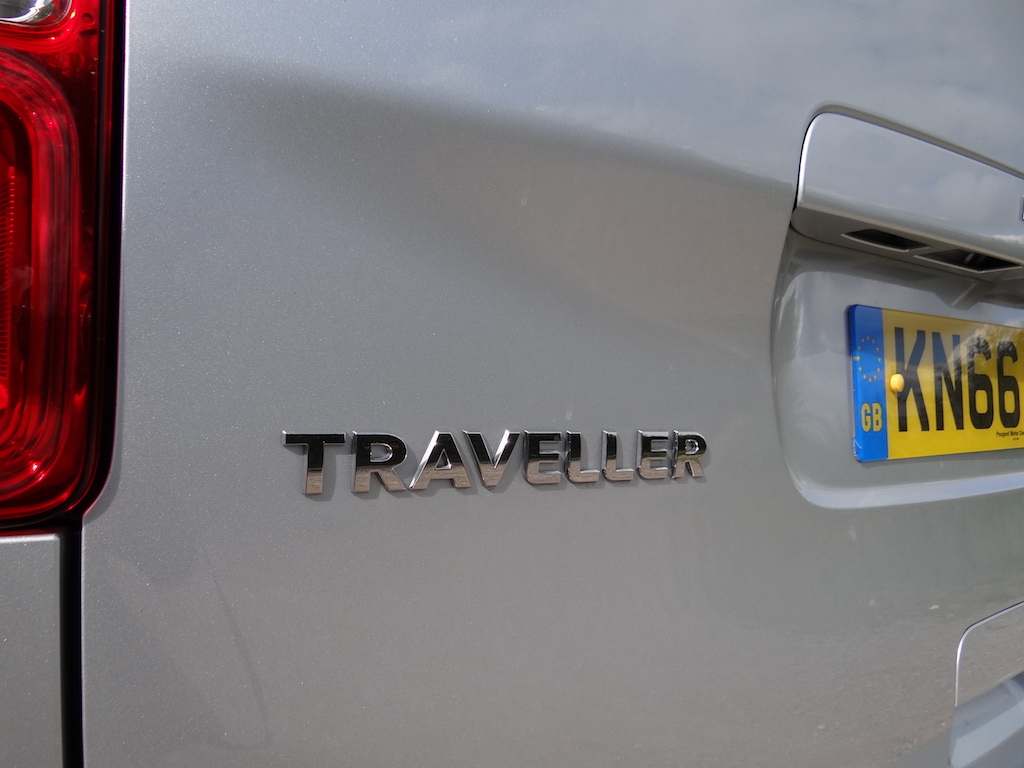
So it is a bit of a throwback to find Peugeot using Traveller as the identifier for its van-like MPV but, at least, it is one vehicle that really does live up to the tag Multi-Purpose Vehicle.
Visually the ‘all-new’ Traveller hasn’t come very far from a light commercial with its blunt pug nose, boxy upright sides, flat roof and vertical rear end – this model is never going to win any beauty prizes.
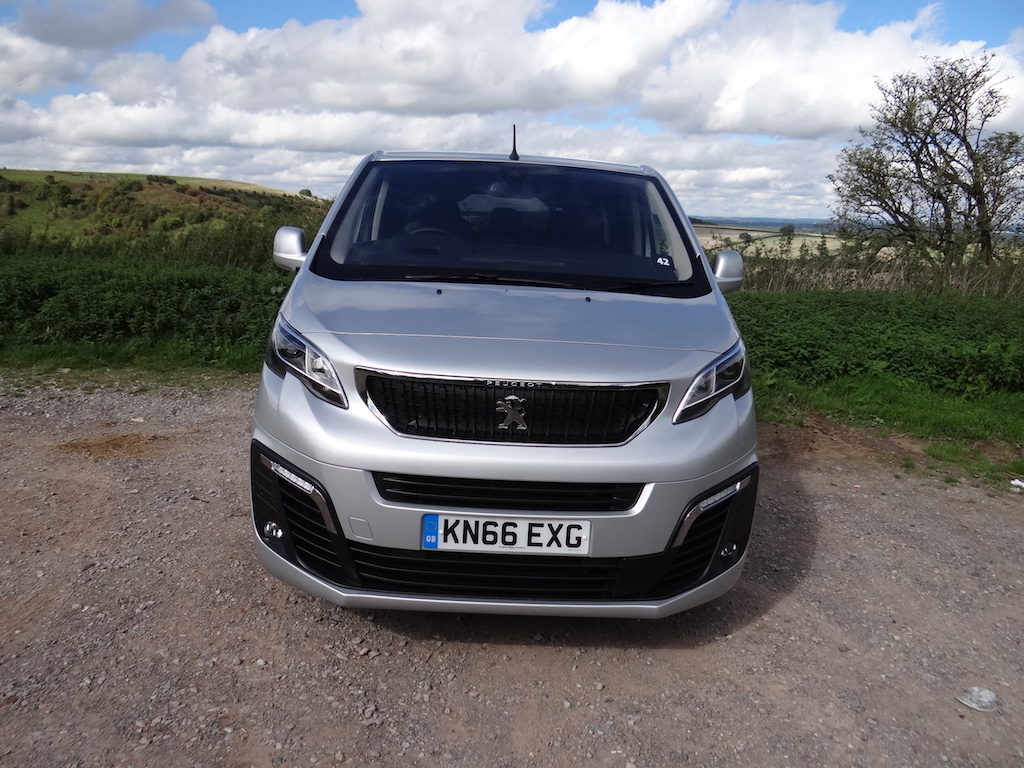
But then again it is purpose-over-presence that is important here and, in this case, the version I have been trying is very much designed for a purpose – as an eight seat VIP shuttle bus (there are also five, six and seven seat alternatives based on the Standard 4.95 metre (16.24 ft) and Compact 4.6 metre (15.09 ft) long bases.
Large families might also consider it as an option but the high specification level might just make it a touch on the expensive side for budget-conscious parents.
Targeted very much at the hotel and business sector, the eight seat configuration (there is also a nine seat option on the 5.3 metre long version) is designed to offer passengers the maximum of comfort in the most economical of layouts.
The individual leather seating throughout (which comes included in the basic price) is bolstered by automatic triple zone air conditioning with rear control vents.
This slideshow requires JavaScript.
Traveller is structured with lots of glass all-round (privacy glass in the rear for those of a shy disposition), including a massive panoramic glass roof so no one should suffer from claustrophobia even with all eight seats in occupation.
The middle row of three individual seats slide backwards and forwards and fold down flat – the generous amount of travel is needed to allow access to the rear row of three seats which also slide and recline to offer either occupant or luggage space.
The seats have another trick up their sleeve – they can be detached to offer even more stowage capacity – up to a massive 4,900 litres (173.04 cu.ft) on the long version with the second and third row seats removed.
For the person with lots of luggage this latter function might be vital as, with all seats occupied, there isn’t much load space left in the Standard version I was driving, although Peugeot promises 1,500 litres (52.97 cu.ft) can be found on the Long length examples.
Heaving bulky objects in and out won’t be a chore thanks to the low sill and high top-hinge for the rear hatch.
Access for passengers is via two electrically-operated side doors, which will open and close easily and effortlessly if you let them do their own hands-free thing (on Allure trim versions). However, the process is a bit complex and slow, which can feel frustrating at times.
In an alternative configuration Peugeot offers the Traveller with four face-to-face seats for those who need to conduct their business on the move.
For the one person on board who isn’t supposed to be enjoying the ride, the driver, the view ahead is big and broad thanks to the huge windscreen, while the upright, van-like dashboard isn’t the most decorative but is clearly very functional with many of the supplementary functions operated from a large seven inch touch screen.
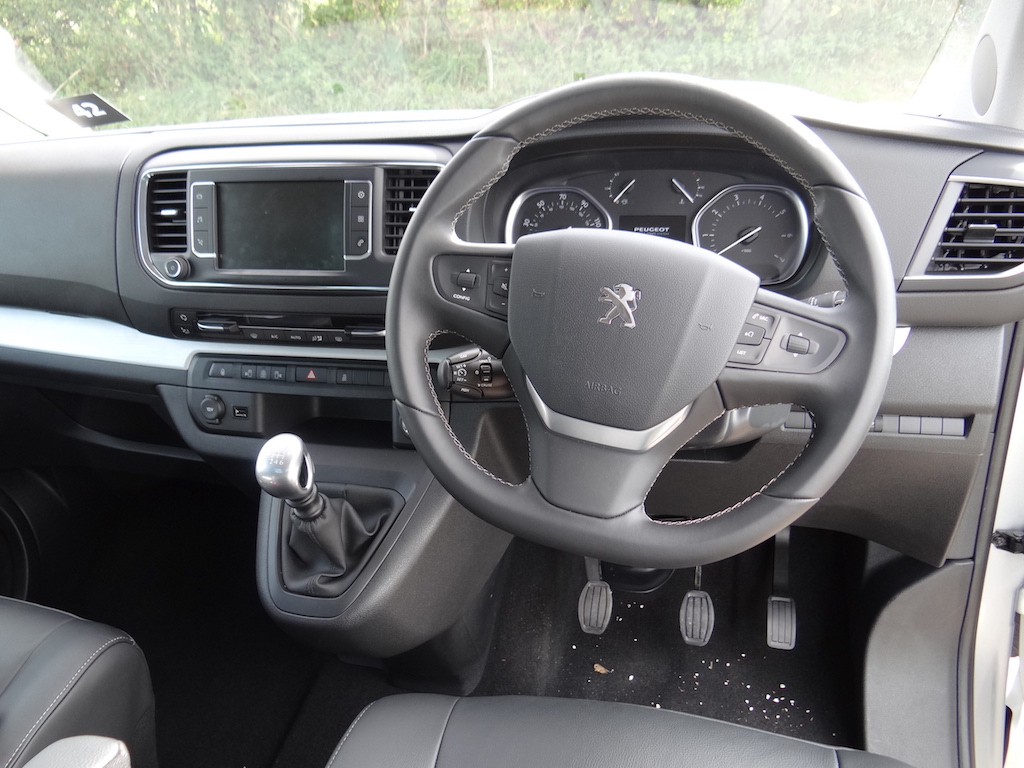
The are also plenty of drive aids such as a rear camera – an essential for reversing into any size space due to the near five metre (16.40 ft) long bulk of the Traveller – this is supplemented by optional front and rear parking sensors (£480) and connect satellite navigation (another £240) while a Driver Assist package (£250) throws in active cruise control, collision alert and active safety braking.
There is even a heads-up display (a feature I never really appreciated until it was fitted to my own vehicle – which just happens to be a Peugeot MPV) and, just to make the driver feel really at home, the front seats are heated and have a welcoming massaging function – a blessing during long journeys.
On the Road
With business operators very much in mind the motive power for the Traveller on test is an efficient if surprisingly small capacity two litre, four cylinder diesel engine (one of five efficient diesels on offer in the Traveller range).
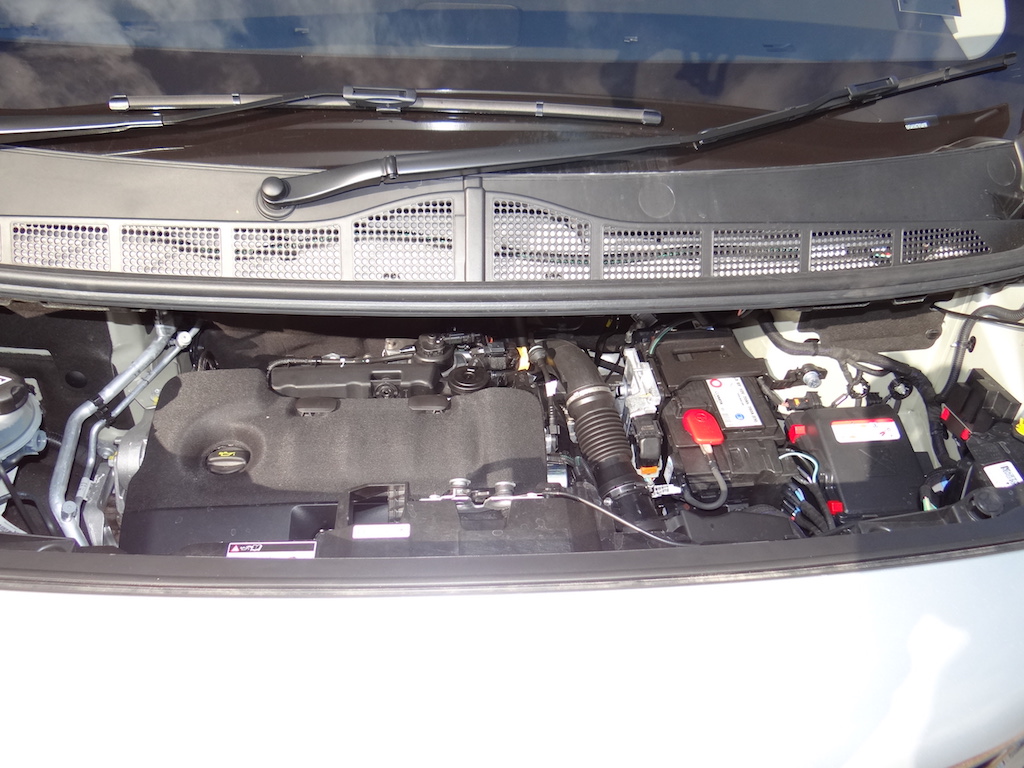
Badged as a Blue HDi power unit, Peugeot claims it is installed with the most efficient pollution control technology available in the market, with a Selective Catalytic Reduction system upstream of the Diesel Particulate Filter – hence the makers can boast of a CO2 figure of 139 g/km, which is best in class.
The modest 110 bhp on tap is managed through a six-speed manual transmission which is conveniently operated from a dash-mounted column that falls easily to hand and which slides gently though the cogs.
Brisk rather than startling performance is the order of the day, and it will at least top 110 miles an hour where permitted, but don’t expect too much away from the traffic lights or on overtaking.
Electro-hydraulic power assisted steering, plus an 11.3 metre (37.07 ft) turning circle will help with parking and city manoeuvring.
Traveller sits on a new platform which has reduced weight and bulk (Peugeot claiming up to 400 kg or 882 lb less than rivals) and uses a Pseudo MacPherson strut front suspension and an oblique wishbone rear suspension to support payloads of up to 1,400 kg (3,086 lb).
Variable stiffness springs and shock absorbers provide a nice balance between comfort of the occupants and a confident handling ability, even with unoccupied.
There is no getting away from the fact that it rides like a van on its 17 inch alloy wheels, with some body roll, but this is not excessive, and the light steering takes away the sensation of the bulk of the Traveller.
The Peugeot Traveller isn’t there to attract admiring glances or to reward the driver with scintillating performance – it is there to do a job of work and from this view it fits the brief perfectly.
Busy business executives or holidaymakers can arrive at their destination in a degree of comfort not normally available in anything less than a coach without feeling that that are being confined to a mini-bus.
This is definitely a new-age Traveller.
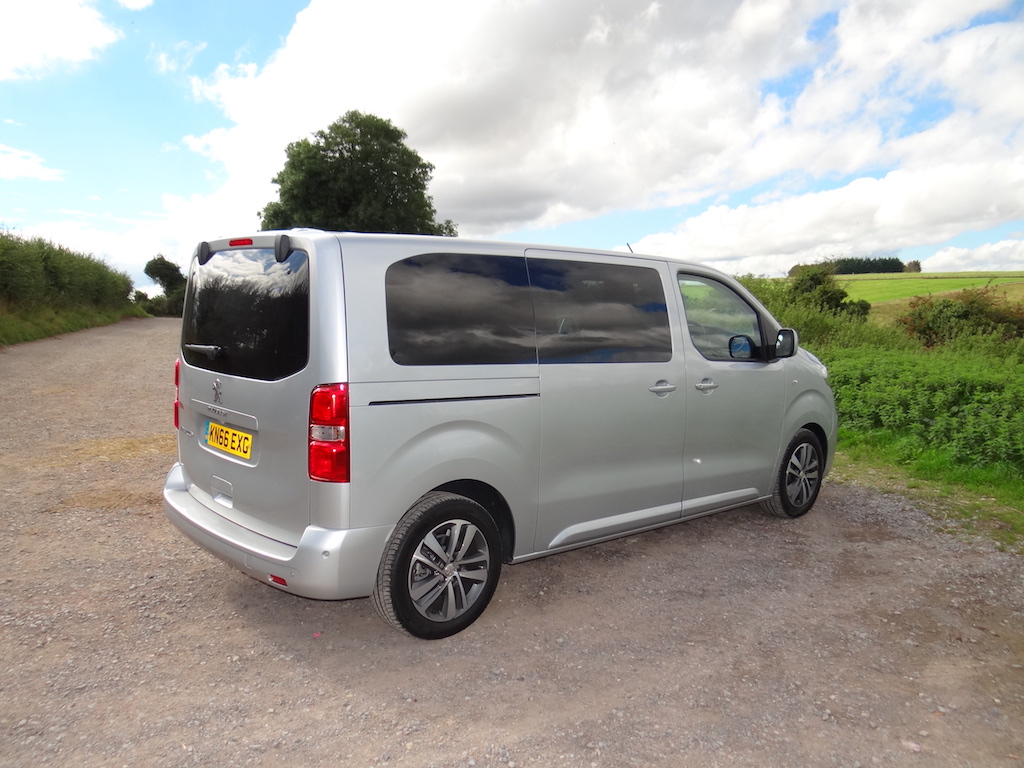
Wheels-Alive Tech. Spec. in Brief:
Vehicle: peugeot traveller allure std blue hdi 150.
Engine: 1997 cc diesel
Transmission: Six speed manual
Power: 110 bhp @ 4,000 rpm
Torque: 370 Nm (273 lb.ft) @ 2,000 rpm
Performance:
0-62 mph: 11 seconds
Top Speed: 106 mph
Fuel Consumption (Official Figures):
Urban: 47.9 mpg
Extra-Urban: 57.6 mpg
Combined: 53.3 mpg
CO2 Emissions: 139 g/km
Price (On the Road): £36,985
Wheels Alive Social
Like us on Facebook
Follow us on Twitter
We welcome your questions, comments and feedback. Please click here to contact us .
Advertising Opportunities
Please contact us if you would like to discuss advertising opportunities on Wheels Alive.
Please share our website
LATEST DEALS:
- Vauxhall Mokka – Save £4766
- Peugeot 3008 – Save £6062
- BMW 3 Series – Save £2830
- Audi A4 – Save £4753
Peugeot e-Traveller review
Category: Van-based MPV
Electric van-based MPV can carry plenty of people but has a limited range and is more expensive than direct rivals.

Share review

Citroën Berlingo


Volkswagen Multivan
Introduction, what car says....
Praise be to the Peugeot e-Traveller because you can now drive your extended family through London without burning fossil fuels or having to resort to one of those expensive horse-drawn carriages.
Yes, you read that right: this very large eight-seat (or seven, if configured as such) van-based MPV is actually an electric vehicle. The e-Traveller is not only quiet enough to avoid startling the horses trotting down The Mall, but also avoids the congestion charge.
Instead of using a diesel engine (as is traditional with van-based MPVs ), you get an electric motor with up to 134bhp. The motor gets its juice from a 50kWh battery pack that you can charge at a rate of up 100kW if you can find a charger capable of that speed.
The e-Traveller's body and electric tech are essentially the same as you’ll find in a Citroën e-Spacetourer and Vauxhall Vivaro-e Life . If you’re wondering where this Peugeot fits into that hierarchy, just know that both those rivals have stripped-out and rather basic entry-level versions to keep the price low, while the e-Traveller is 'the posh one', aiming to take on the Mercedes EQV .

What Car? has a buying service
So does the Peugeot e-Traveller successfully fit into the niche but expanding sector of zero-tailpipe emissions people carriers, and how does it compare with the best MPV rivals?
Read on through this comprehensive review to find out whether it's good to drive, how comfortable all those passengers will be, whether the running costs are manageable, which trims and engines we rate and much more.
When you're ready to buy a new vehicle of any make and model, don't forget that you can track down the best prices using our free What Car? New Car Buying service . It has lots of Peugeot e-Traveller deals .
Performance & drive
What it’s like to drive, and how quiet it is.
Your Peugeot e-Traveller engine choice is simple because there's only one option: an electric motor borrowed from the Peugeot e-208 and Peugeot e-2008 . There are three drive modes – Eco, Normal and Power – which vary the available power considerably, up to a maximum 134bhp.
The Power mode gives you the full whack, with the potential for 0-62mph in a not bad (for a massive passenger van) 10.8sec. If you stick the e-Traveller in Eco when you’re running low on juice, you’ll only have 80bhp to play with and a vehicle that will struggle to top 65mph on a level motorway.
Speaking of range, the e-Traveller has an official figure of 148 miles, and that's fairly typical for this size of van-based MPV . You can expect to get significantly less (potentially under 100 miles in our hands) if you’re travelling on a motorway while loaded up with people and luggage. The Mercedes EQV has a much longer potential range north of 200 miles.

You can improve the range by using the gearbox’s ‘B’ mode for increased regenerative braking. This puts energy back into the battery while slowing the vehicle down, lowering your overall consumption. Even without it engaged, the brakes are pleasantly progressive as they switch between regeneration and the vehicle’s mechanical brakes.
Ride quality – which is usually of greater importance than performance in a people hauler – is generally fine. Compared with a non-electric Toyota Proace Verso (which has the same platform), the e-Traveller isn’t as settled over scruffy road surfaces.
That may change with passengers on board, but it will still end up feeling quite bouncy over undulations at speed. Plus there’s a significant ‘thwack’ sound that reverberates through the interior when you hit a big pothole at town speeds. Fortunately, there’s no real motor whine of note while you’re driving the e-Traveller, and wind and road noise are well contained.
On the road, you won’t be mistaking the e-Traveller for a smaller MPV like the Volkswagen Touran , but it is at least just as easy to drive. The steering is pretty accurate, although it does involve a lot of arm twirling when parking. At higher speeds, the body leans a bit in tighter bends, but you get used to that after a while, and generally appreciate the e-Traveller’s decent grip levels that allow you to maintain your pace down a country road.

The interior layout, fit and finish
One of the benefits of going for the Peugeot e-Traveller over regular MPVs and seven-seat SUVs is that you tower over other vehicles. That’s thanks to its commanding driving position, even in the seat’s lowest setting (you get height adjustment as standard). In typical van fashion, you sit above the pedals, which could take some getting used to if you’re coming from a car or SUV.
The boxy shape of the e-Traveller makes it easy to judge the width, but you can't see the stubby nose from the driving seat, although if you go for the top-end Allure version, you get front parking sensors, which you can’t add to the Citroën e-Spacetourer or Vauxhall Vivaro-e Life .
Citroën gives you rear parking sensors as standard to help when reversing in tight spaces, but a rear camera is only available as part of an expensive visibility pack on Active, or standard on Allure trim.
The e-Traveller doesn’t sound like a van, but it can’t hide its commercial vehicle heritage inside. Even the poshest Allure trim, with its ‘brushed aluminium’ inlays and leather seats, can’t hide the acres of hard plastic. At least rear air-con is standard, and the overhead console comes with plenty of air vents for good ventilation. A Mercedes EQV is quite a lot more premium inside, though.
All versions of the e-Traveller get a 7.0in touchscreen infotainment system with Bluetooth, a DAB radio, Apple CarPlay and Android Auto smartphone mirroring, and a USB socket. Sat-nav is an option on Active and standard on Allure. It’s a fairly easy system to navigate but some of the icons are small and it can be a bit sluggish to respond to commands. Allure models have a grander nine-speaker sound system that sounds plenty good enough, although it’s probably helped by the lack of engine noise getting in the way.

Passenger & boot space
How it copes with people and clutter.
You can have your Peugeot e-Traveller in either Standard or (with top-end Allure trim) Long, and you can fit eight people inside comfortably, with plenty of head, leg and shoulder room to go around. The difference is, you’ll have an easier time hauling around the luggage of those eight people in the Long version because it has a bigger boot.
The benefit of opting for such a large vehicle is that you can fit six actual people across the second and third rows.
The seats can be reclined for additional comfort and have Isofix mounts so you can fit child seats. They also slide so you can trade boot space for leg space if required, and all rows get a 12v socket for charging various devices.
A seven seat configuration with two ‘captain’s chairs’ for the second row is available for additional cost. They can be spun round if you fancy ignoring the driver and having a conversation with the people in the third row.
The e-Traveller in Allure trim has a panoramic sunroof as standard, and it lets lots of light into the rear without making much difference to the very generous headroom available.
Even with all three rows in place, there’s enough space in the e-Traveller’s boot to handle lots of holiday luggage. You have to leave a good space behind the car when you park, though, because the long tailgate is hinged from the top and needs plenty of room to swing open. Top-spec Allure helps with this by including a rear glass window that can be opened separately.

Buying & owning
Everyday costs, plus how reliable and safe it is.
The Peugeot e-Traveller is more expensive to buy than the Citroën e-Spacetourer or Vauxhall Vivaro-e Life . Both rivals have stripped-out entry-level versions that qualify for the Government’s electric car grant making them even cheaper, while no e-Traveller qualifies. The premium Mercedes EQV is much more expensive than all three.
You can recharge the e-Traveller’s batteries pretty quickly. According to official figures, it’ll take around 30 minutes to go from a 10-80% charge if you can use a 100kW charging station . A domestic 7kW wallbox charger will complete a full charge from empty in 7.5 hours.
There are two trim levels available. Entry-level Active cars get manual air-con, cruise control, a digital radio with a 7.0in infotainment system, 17in alloy wheels and rear parking sensors. The Allure trim – which you have to have if you want the longer L model – adds Xenon headlights plus front parking sensors and a reversing camera, leather trim, electrically heated and adjustable front seats, a better stereo, and keyless entry and start.
Safety kit includes automatic emergency braking (AEB), adaptive cruise control, lane-keeping assistance and driver drowsiness monitoring (in the Driver Assist pack). Blind-spot warning is standard on Allure trim to help spot traffic along your flanks.
Peugeot didn’t do particularly well as a brand in our latest 2021 What Car? Reliability Survey , coming in joint 22nd place with Mercedes and Vauxhall. Citroën did much better, coming 11th out of the 30 manufacturers included.
Every Peugeot gets a three-year warranty, and the battery pack is covered under a separate eight-year or 100,000 mile warranty.
For all the latest reviews, advice and new car deals, sign up to the What Car? newsletter here

Explore more of the Peugeot e-Traveller
- Full review Currently reading

Best MPVs: our top 10 revealed

Peugeot e-3008 reader test team

2024 Peugeot e-3008 electric car review

Deal of the Day: Save more than £4200 on a new Peugeot 308 SW

Peugeot 408 long-term test: report 4

Peugeot rolls out in-car artificial intelligence
More peugeot traveller, new reviews.
Peugeot Traveller
Also consider

Unrivalled interior space for the money; surprisingly&nbs...

Citroën e-Berlingo
Electric van-based MPV is peaceful to drive and tough to beat...

Peugeot Rifter
It may not have the class of more mainstream MPVs, but the Peu...

Peugeot e-Rifter
Electric van-based MPV is refined, very practical and wel...
All Van-based MPV car reviews
Quick search.
- All car reviews
- All new car deals
- Used cars for sale
- All used makes
- Vans and commercial vehicles
- New car awards
- Used car awards
- Classic & Sports Car
- Move Electric
Tools & services
- Car finance
- Car warranty
- Gap insurance
- Sell your car
- Car Leasing
- Car Valuation
- Company car tax calculator
- Van tax calculator
- Terms & conditions
- Cookie policy
- Privacy policy
Information
- About What Car?
- Contact What Car?
- Subscribe to our newsletter
- Subscribe to What Car? magazine

What Car? is part of Haymarket Automotive , a division of Haymarket Media Group © Haymarket Media Group 2024

Browse by car body
- convertible car
- hatchback cars
- station wagon cars
- Minivan cars
- Diesel cars
- Hybrid/Electric

Peugeot e-Traveller Crash test result
The model peugeot e-traveller is produced by peugeot between and 2020. they were produced 1 versions in total. the body type is van. the engine's fuel type is electric with transmission automatic and power 136 hp. the crash test result is *****. the top speed is 0 km/h. peugeot e-traveller crash test result vary according to year of production, body type, fuel type, transmission or power. peugeot e-traveller crash test result list., people who viewed peugeot e-traveller crash test result also viewed.
- Peugeot e-Traveller Body warranty
- Peugeot e-Traveller Urban consumption
- Peugeot e-Traveller Ground clearance
- Peugeot e-Traveller Valves per cylinder
- Peugeot e-Traveller Rear brakes
- Peugeot e-Traveller Service
- Peugeot e-Traveller Acceleration
- Peugeot e-Traveller Fuel costs
- Peugeot e-Traveller Energy label
- Peugeot e-Traveller Rear tire size
- Peugeot e-Traveller Rear suspension
- Peugeot e-Traveller Transmission
- Peugeot e-Traveller Compression ratio
- Peugeot e-Traveller Curb weight
- Peugeot e-Traveller Front track width
- Peugeot e-Traveller Power kw
- Peugeot e-Traveller Power hp
- Peugeot e-Traveller Cylinders
- Peugeot e-Traveller Front suspension
- Peugeot e-Traveller Width
- Peugeot e-Traveller Cargo capacity
Peugeot e-Traveller MPV review
"big, simple and economical, the electric peugeot e-traveller is a sensible choice for comfortable group travel".

3.8 out of 5
2.0 out of 5
- Generous equipment
- Loads of interior space
- Economical for its size
- Obviously van-based
- Rather noisy in the back
- Awkward boot when all seats are in place
Like SUVs, MPVs are offered in all kinds of shapes and sizes. Peugeot will sell you anything from the small, utilitarian, van-based Peugeot e-Rifter to the larger, more sophisticated Peugeot 5008 , which has the look of an SUV but is a seven-seat MPV at heart. But if you have even more people or equipment to transport, there’s the Peugeot e-Traveller, which is available in two body lengths, accommodating up to eight occupants. Originally sold with diesel engines, the range went all-electric at the start of 2022.

The Mercedes V-Class and Volkswagen Caravelle can also carry up to eight people and while the e-Traveller might wear a less well-known badge, it's a credible rival to both. Inside and out it’s almost identical to the Citroen SpaceTourer and Toyota Proace Verso, which isn’t surprising, since all three come from the same production line. And in common with the Mercedes and Volkswagen above, all three MPVs are based on commercial vans.
That may not seem very upmarket, but in fact it makes a lot of sense. A van is designed to offer as much interior space as possible, so MPVs such as the e-Traveller provide the most generous accommodation for large groups of passengers. All occupants can stretch out in some comfort and the extended-wheelbase version offers even more room. The longer model also maximises luggage space behind the third row of seats.
More reviews
Peugeot expert review.
Most importantly, vans are expected to work for a living, while generating a profit for their commercial users, so they have to be cheap to run. The e-Traveller can be charged as cheaply as the user's electricity tariff will allow, or it can be topped up using public chargers, which still costs significantly less than filling up with diesel. Once full, the battery provides around 140 miles of range, which is more than enough to cover off the majority of daily trips.
Compared to its Citroen and Toyota stablemates, the Peugeot is positioned a little way upmarket – there’s no economy-priced basic model. Every e-Traveller is pretty well equipped, with air-conditioning, cruise control, Bluetooth and a seven-inch infotainment screen even on the least expensive Active model. Go for Allure and you get heated and massaging leather seats, a panoramic sunroof, a rear-view camera and a heads-up display for driver convenience.
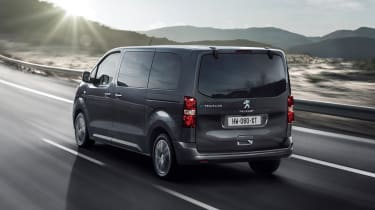
You wouldn’t expect something as long and wide as the Traveller to feel like a sports car, but it doesn’t feel as bulky or intimidating as you might expect. It’s actually surprisingly nimble, so crowded urban streets can be tackled with confidence. Also adding to driver confidence is the Traveller’s five-star Euro NCAP safety rating, with a particularly high score for protecting child occupants in an impact.
In all likelihood, the Peugeot Traveller will be too bulky for family use, unless eight seats are essential. However, a larger family will find the big Peugeot a comfortable, flexible and economical way of travelling together in safety.
Range, charging & running costs
One way the Peugeot e-Traveller betrays its commercial-vehicle origins is in its running costs – they’re low enough not to look too bad on a profit-and-loss spreadsheet. This is excellent news for those who plan to use a Traveller for private hire or executive transport, but it’s equally relevant if the car is to be a workhorse for a large family.
In early 2022, Peugeot took the bold step of deciding to discontinue diesel engines in the Traveller – despite their past popularity in large MPVs – and make it an electric-only model.
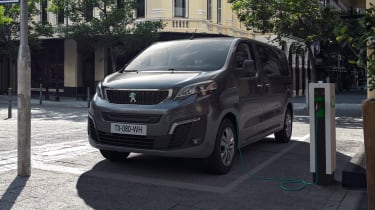
The e-Traveller is certainly the cheapest version to run, especially among business buyers, for whom the zero-CO2 emissions bring the perk of the lowest BiK company-car tax payments.
First launched in 2021, the e-Traveller uses a 50kWh battery to give it a range of just more than 140 miles. It also qualifies for VED (road tax) exemption and should be free to drive into low-emissions zones.
Previously, the engine range was shared with the Citroen SpaceTourer and Toyota Proace Verso, and its most economical member – the BlueHDi 120 with stop-start technology – could achieve up to 46.5mpg.
Those who wanted more power were served by the BlueHDi 145, which returns 42.5mpg and is available with a six-speed manual or eight-speed automatic gearbox. The latter was standard for the BlueHDi 180, which can also return 42mpg. Servicing can be carried out by any Peugeot dealer and is unlikely to cost significantly more than for a Peugeot family car, particularly since electric cars are easier to maintain. The three-year warranty will be the same, too.
Electric motor, drive & performance
Most drivers will find the electric powertrain smoother and more relaxing, thanks to its quiet hum, linear acceleration and absence of need for gearchanges. If you often drive in traffic, or make lots of short trips around town, this makes it a breeze to hop in, whizz to your next stop and jump out with the minimum of fuss.
The main giveaway the e-Traveller is based on a van is its vague steering, which is low-geared to reduce driver effort. The turning circle is tight, though, so manoeuvring in city streets isn’t as hard work as you might expect. The ride is comfortable, too. Venture onto country roads and speed up a bit and the e-Traveller feels stable and handles surprisingly well – although you’re always aware that you’re driving a big, heavy vehicle.
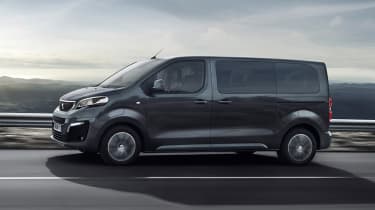
Every e-Traveller gets the same single electric motor, sending power to the front wheels. With 136bhp and instant torque as soon as you touch the accelerator, it feels punchy enough, which is a good thing considering it needs to haul up to eight occupants and their luggage. In most situations the middle driving mode (each one alters the amount of power on tap) is more than adequate, and feels easier to drive smoothly. The Eco mode feels a bit sluggish, so is best reserved for times when every last mile of range is needed.
When internal-combustion engines were still offered, three power outputs were available from a choice of two diesel engines. The 1.5-litre BlueHDi 120 offered 116bhp, while the 2.0-litre BlueHDi 145 and 180 provided 142 and 175bhp respectively.
The BlueHDi 120 manages 0-62mph in 12 seconds and has a higher top speed of 99mph, so it's able to keep up with traffic without feeling too strained.
The 142bhp 2.0-litre diesel comes close to feeling car-like, with strong pull through the gears, although its outright acceleration won’t match most modern family cars. This engine also uses the six-speed manual gearbox, which we found rather ponderous and imprecise. The 175bhp version of this engine feels most upmarket, largely thanks to its automatic gearbox. It can get from 0-62mph in a competitive 9.1 seconds.
Interior & comfort
Passengers in this kind of vehicle aren’t usually very concerned with such issues as running costs and performance – comfort is key to their satisfaction and it’s highly unlikely that they’ll be disappointed.
Equipment is generous on both of the two models available. Active has a dual-zone climate control system, cruise control for relaxed motorway driving, a DAB radio, Bluetooth and a seven-inch infotainment screen. The Allure adds power-adjustable heated front seats, leather trim, a panoramic glass roof, keyless entry and xenon headlights. Sat nav (with TomTom Live updates for three years) is also fitted as standard in Allure versions.
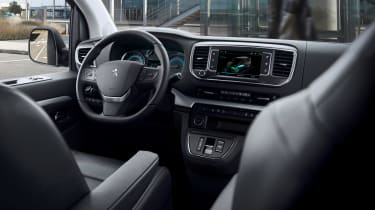
As a van-based vehicle, the e-Traveller has a simple and fairly upright driver’s environment, which the long-legged may find restrictive. The dashboard itself is smart if not the last word in cutting-edge design, while materials are solid and workmanlike.
The trim elsewhere inside – including the seats – doesn’t quite match the feeling of luxury provided by the more expensive Volkswagen Caravelle, but comfort is good and few passengers are likely to feel hard done by – although it’s a bit noisy inside and the huge interior can seem a bit echoey.
Practicality & boot space
This is the category where a jumbo MPV really sells itself, as well as laying its van-based roots well and truly bare. As you might expect, the Peugeot e-Traveller offers an immense amount of interior space. You can choose two body lengths: standard and long, with the compact version no longer offered.
We haven’t sampled the compact model, but our standard-length e-Traveller could comfortably accommodate six-foot passengers in each of its three seating rows, while leaving space for 603 litres of luggage, even with all eight seats in use. The long version extends this to a huge 989 litres.
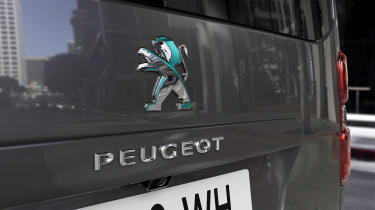
However, that load space is tall, wide and shallow – imagine the outline of a chequebook and you’ll get an idea of the shape of the boot. Bulky bags may need to be stored vertically. Plus, the seats are heavy and removing them isn’t easy, but if you need a truly vast carrying capacity, 3,061 litres (standard version) can be unlocked by heaving them out – and that’s only measured to the window line. The long-wheelbase version has 3,497 litres up to the window line, but will be somewhat harder to park, and therefore to live with.
Reliability & safety
No operator of vans will want its fleet to suffer from excessive downtime and as such commercial vehicles are typically designed to have as few potential failure points as possible. With that in mind, much of the technology found under the metal of the e-Traveller is pretty simple and its engines have been proven with high mileages accumulated by van drivers all over Europe.
Neither of the e-Traveller’s sister models, the Citroen e-SpaceTourer and Toyota Proace Electric, has yet made an appearance in our annual Driver Power owner satisfaction survey, but we hope they will as their popularity increases. Peugeot itself presently ranks 11th overall out of 29 manufacturers surveyed, just behind 10th-placed Lexus and comfortably ahead of Volkswagen in 17th.
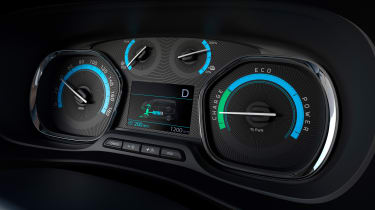
The Traveller’s safety is beyond any criticism, though. It holds a five-star rating from Euro NCAP , including an 87% score for adult passenger protection and an excellent 91% score for child protection. Thanks to autonomous emergency braking – which will apply the brakes if an oncoming hazard is detected – a 64% rating was given for pedestrian protection.
Lane-departure warning, road-sign recognition, blind-spot monitoring and a driver drowsiness monitor improve safety on long journeys – as does active cruise control, and these helped the Traveller to gain a 78% Euro NCAP rating for driver assistance.
- Electric cars
- e-Traveller
- e-Traveller MPV
Richard is a former editor of Carbuyer, as well as sister site DrivingElectric.com, and he's now Deputy Editor at Auto Express. Having spent a decade working in the automotive industry, he understands exactly what makes new car buyers tick.
Recommended
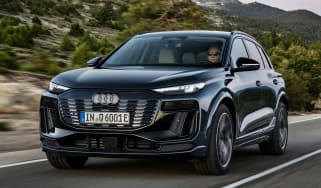
New Audi Q6 e-tron SUV sneaks under £60k
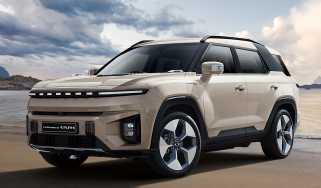
New KGM Torres EVX is a £44k electric SUV from rebranded Ssangyong
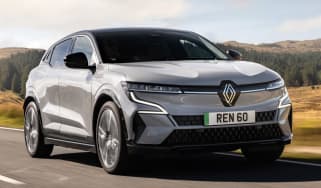
Renault Megane E-Tech review - a sporty, yet comfortable EV
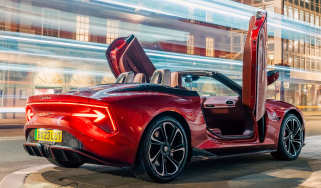
New MG Cyberster EV sports car goes on sale in the UK from £54,995
Most popular.
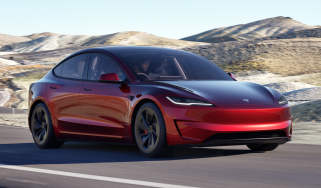
New Tesla Model 3 Performance: rapid 454bhp EV costs £60k
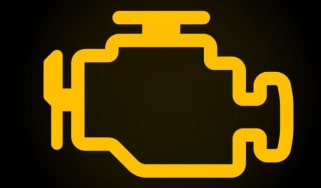
Engine management light: top 5 causes of amber engine warning light

Best new car deals 2024: this week’s top car offers
More on e-Traveller

Top 10 cars with the biggest boots
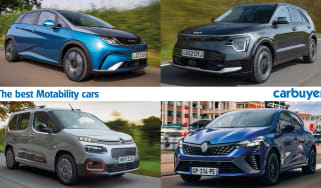
Top 10 best Motability cars 2024

Top 10 best cars with sliding doors
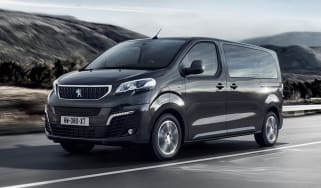
Electric Peugeot e-Traveller MPV revealed
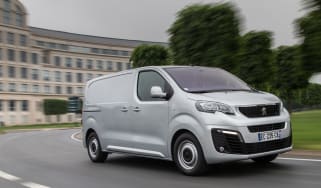
Tips & advice

Car dashboard warning lights: the complete guide

Electric car charging stations: a complete guide

PCP vs HP – which type of car finance is right for you?

Average speed cameras: how do they work?

Top 10 best car interiors

Top 10 best electric cars 2024

Top 10 best cheap-to-run cars 2024

The UK's top 10 fastest hot hatchbacks 2024

- New comments
- Military Photos
- Russian Military
- Anti-Aircraft
- SA-21/S-400 Triumf

5P85TM Launch Unit for S-400
- Oct 18, 2010
Media information
Share this media.
- This site uses cookies to help personalise content, tailor your experience and to keep you logged in if you register. By continuing to use this site, you are consenting to our use of cookies. Accept Learn more…
- History of cooperation
- Areas of cooperation
- Procurement policy
- Useful links
- Becoming a supplier
- Procurement
- Rosatom newsletter
© 2008–2024Valtiollinen Rosatom-ydinvoimakonserni

- Rosatom Global presence
- Rosatom in region
- For suppliers
- Preventing corruption
- Press centre
Rosatom Starts Life Tests of Third-Generation VVER-440 Nuclear Fuel
- 16 June, 2020 / 13:00
This site uses cookies. By continuing your navigation, you accept the use of cookies. For more information, or to manage or to change the cookies parameters on your computer, read our Cookies Policy. Learn more

IMAGES
VIDEO
COMMENTS
CRS Installation Check 12.0 Pts. Comments. The Traveller scored maximum points for its protection of the 1½ year dummy in the full scale crash tests. In the frontal test, forward movement of the 3 year dummy, sat in a forward-facing restraint, was not excessive and protection was good apart from marginally raised neck tension.
Results also valid for Citroen Spacetourer and Toyota Proace
TEST RESULTS Tested Model Peugeot Traveller 2.0 diesel, 'Navette', LHD Body Type - Van Year Of Publication 2015 ... The Traveller scored maximum points for its protection of the 1½ year dummy in the full scale crash tests. In the frontal test, forward movement of the 3 year dummy, sat in a forward-facing restraint, was not excessive and ...
Il crash test Euro NCAP sulla Peugeot Traveller, valido anche per Citroen Spacetourer e Toyota Proacehttp://www.sicurauto.it/crash-test/euroncap/peugeot-trav...
Frontal Impact takes place at 64 Km/h, 40% of the width of the car striking a deformable barrier. In the side impact, a mobile deformable barrier impacts the...
Two engines are available for the Peugeot Traveller - a 1.6-litre or a 2.0-litre BlueHDi diesel, with a choice of four power outputs between them. ... All Travellers get a five-star crash safety ...
The engine is a 150bhp HDi, and it does a stout job, without making much fuss. It supposed to be able to beat 100mph, but boy that'd need a run-up. The 0-62 time of 11 seconds gives a better ...
The Peugeot Traveller sailed through its 2015 Euro NCAP crash test with five stars, with strong performances in all the categories, particularly child occupant protection where it managed 91%. This will have been thanks in part to its many ISOFIX points, but a decent number of airbags will have helped too. The driver and passenger both get ...
Side impact test In the side impact a mobile deformable barrier impacts the drivers door at 50 km/h
On this page you will find Euro NCAP's latest ratings, sorted by the date of publication, by star rating and by make in alphabetical order. Some cars appear twice: one assessment indicates the basic safety rating, applicable to a car with only standard equipment; the other shows the safety level which can be achieved with the additional safety ...
Very spacious but handling and interior quality are likely to disappoint those used to a regular MPV. Spacious and flexible interior. Largely comfortable ride. Seating for up to nine. Wallowy ...
At the time of this test, that wasn't being offered on the e-Traveller. Design and Build. A key advantage that this e-Traveller model enjoys over its identically-engineered Citroen e-SpaceTourer and Vauxhall e-Vivaro Life MPV People Carrying design stablemates is the fact that this Peugeot offers customers a choice of body lengths.
The are also plenty of drive aids such as a rear camera - an essential for reversing into any size space due to the near five metre (16.40 ft) long bulk of the Traveller - this is supplemented by optional front and rear parking sensors (£480) and connect satellite navigation (another £240) while a Driver Assist package (£250) throws in active cruise control, collision alert and active ...
Euro NCAP car crash and accident test about Peugeot Traveller 2.0 diesel, 'Navette', LHD.The passenger compartment remained stable in the frontal impact. Dum...
Peugeot e-Traveller Review 2024, Price & Specs | What Car? LATEST DEALS: Vauxhall Mokka - Save £4766. Peugeot 3008 - Save £6062. BMW 3 Series - Save £2830. Audi A4 - Save £4753.
The model Peugeot e-Traveller is produced by Peugeot between and 2020. They were produced 1 versions in total. The body type is Van. The engine's fuel type is Electric with transmission Automatic and power 136 hp. The Crash test result is *****. The top speed is 0 km/h. Peugeot e-Traveller Crash test result vary according to year of production ...
The BlueHDi 120 manages 0-62mph in 12 seconds and has a higher top speed of 99mph, so it's able to keep up with traffic without feeling too strained. The 142bhp 2.0-litre diesel comes close to ...
The Russian Knights commander, Col. Igor Tkachenko, seems to of predicted his own death. Col. Tkachenko had publicly commented on the poor state of the 4x Su-27P and 2x Su-27UB fighter jets recently, saying that the planes were in too poor a condition to be flown by a regular fighter squadron. He also said that the required maintnence was not being done and that the chances for something to go ...
Hearings for the inquiry into the crash resumed on Monday. Captain Andrew Balaam, a MRH-90 pilot posted to the School of Army Aviation, said a test of the latest software upgrade V5.10 for the ...
Elektrostal is a city in Moscow Oblast, Russia, located 58 kilometers east of Moscow. Elektrostal has about 158,000 residents. Mapcarta, the open map.
First S-400 btln, Elektrostal Moscow.
TEST RESULTS Tested Model Peugeot Traveller 2.0 diesel, 'Navette', LHD Body Type - Van Year Of Publication 2015 Kerb Weight 1900kg ... The Proace scored maximum points for its protection of the 1½ year dummy in the full scale crash tests. In the frontal test, forward movement of the 3 year dummy, sat in a
The life tests started after successful completion of hydraulic tests (hydraulic filling) of the mock-up with the aim to determine RK3+ hydraulic resistance. Life tests are carried out on a full-scale research hot run-in test bench V-440 and will last for full 1500 hours. The aim of tests is to study mechanical stability of RK3+ components ...
#technologyaapkeliye Follow on me#Instagram:-https://goo.gl/3LhzD2Facebook:-https://goo.gl/fuyikqGoogle+ :-https://goo.gl/62xMPk(official website) :-https://...